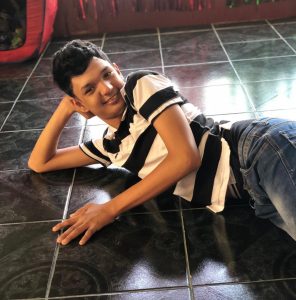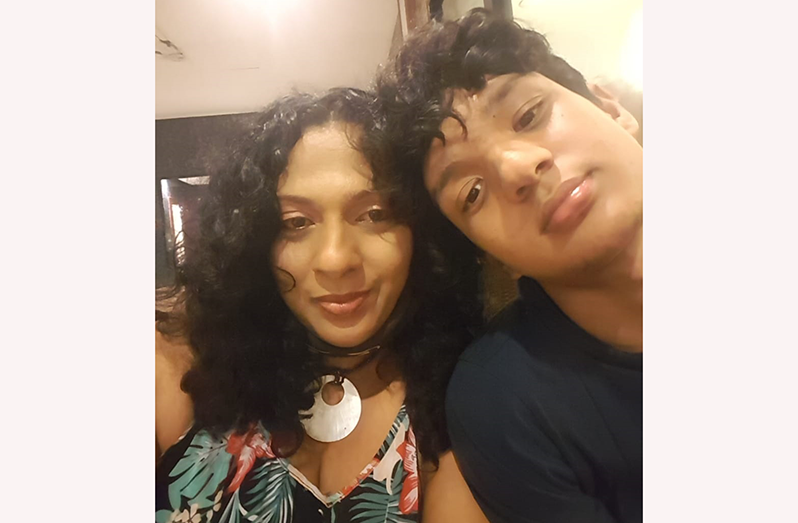By Telesha Ramnarine

SIXTEEN years ago when her son was just two years old, Anjalena Beshpatty was keen to pick up on a few things that her son was doing differently from other kids his age. Even though she’d never heard about Autism before, she wasted no time in trying to find out just what was wrong with her boy.
And to this day, the 46-year-old mother of three is happy that when she noticed her son was non-verbal, she didn’t listen to others who kept telling her to hold on – that he will speak in his own time. She busied herself from clinic to clinic, doctor to doctor, trying to get a sense of the possibilities.
Perhaps it was these diligent efforts not to waste a minute that have allowed her autistic son Sameir to turn into a happy, independent 18-year-old who now assists her with her work of helping other families in similar situations today.
From the moment she saw that Sameir was not talking, crying, or wanting to play with other children, Anjalena reached out to a health clinic at Parika with visiting doctors and it was there that she was told about Autism, or Autism Spectrum Disorder (ASD).
“I then went to an internet café and read about it and was devastating [sic]. I did a checklist online and I didn’t want to believe that my son was checking off on so many things. I really had to be honest and tell myself this was it,” Anjalena, now an Occupation Autism Educational Consultant, said in an interview with Pepperpot Magazine.
According to the Centers for Disease Control and Prevention (CDC), the national public health agency of the United States of America, ASD is a developmental disability that can cause significant social, communication and behavioural challenges, with people communicating, interacting, behaving, and learning in ways that are different from others.
While some people with ASD need a lot of help in their daily lives, others need less. Having realised that her son falls into the category of the former, the next few years of Anjalena’s life would see her spending her mornings at play and nursery school with her beloved Sameir. She’d go to the school almost every day, then go home to do her lettuce business.
It was a struggle. Her husband worked a shift system and long hours, which meant that for most of the time, it was just her, Sameir and his sister, Anzalena, who was just two years older. She didn’t want to deprive her daughter of a normal childhood, so in addition to caring for her son with special needs, Anjalena had to find time for the girl.

And things were hard on Anzalena too, as she was being teased about her brother in school. It was just a fence that separated the two schools. So often, she’d just cry and remain in her classroom throughout the day. Anjalena came to the rescue when she asked the school’s permission to talk to the children about Autism. The children simply needed to understand what was happening to Sameir; they did afterwards and the teasing stopped.
By this time, Anjalena had moved away from her family at Mahaicony to live at Cornelia Ida, West Coast Demerara, so her loved ones were too far away to offer any practical help. Anjalena, therefore, had to include her kids in everything that she was doing.
Eventually, she began studying Autism and learnt Applied Behaviour Analysis (ABA). She made her way to the Melmark Autism School in Massachusetts, and took courses at several other schools.
Having worked for 11 years at the Step-by-Step Foundation, she decided to start her own practice. “I did not want Sameir to settle where he was. I wanted more for him and also to help more children. You’re limited in what you can do when you work with people,” Anjalena said. Though she has a private clinic at her home, her work is overseen by clinical doctor Jim Ellis and speech pathologist Kerry Davis, both overseas-based.
Anjalena visits about seven children with Autism in their homes and has about 11 coming for therapy at her clinic.
Put the child first
Bringing up Sameir and his two sisters was no walk in the park for Anjalena. She recalls that everything seemed chaotic at one point, but the best thing she could have done was to put her children’s interests first.

“I had very long days and nights,” she recalled, adding, “I would sleep late in the nights as I had to do certain things after Sameir went to sleep. When he got very upset, I would calm him down by putting him in a tub with water, while I did my work around him. It was really hard to see him struggle like that.”
Simple things like using the toilet, brushing his teeth and sitting down to eat became difficult, frustrating tasks. But this never kept Anjalena from being the best parent she could to Sameir. In fact, she calls him a blessing to her life and credits him for all that she can do today to help other families with special needs children.
“I still struggle with parents who don’t want people to know they have a child with special needs. That means you’re more focused on yourself and not on your child who needs the help. It’s ok to have a child with special needs; it’s not the end of the child’s life or the end of the world,” she remarked.
She further advised: “Be patient with your children and don’t have too many expectations. Show them what you want and teach them multiple times, because they may not be capable of copying you in their actions.”
Meanwhile, according to the CDC, people with ASD often have problems with social, emotional, and communication skills. They might repeat certain behaviours and might not want change in their daily activities. Many people with ASD also have different ways of learning, paying attention, or reacting to things. Signs of ASD begin during early childhood and typically last throughout a person’s life.
While there is currently no cure for ASD, the CDC said research shows that early intervention treatment services can improve a child’s development. ASD occurs in all racial, ethnic, and socioeconomic groups, but is about four times more common among boys than among girls.
All of the causes of ASD are not known, but the CDC said there may be many different factors that make a child more likely to have an ASD, including environmental, biological and genetic factors.




.png)









